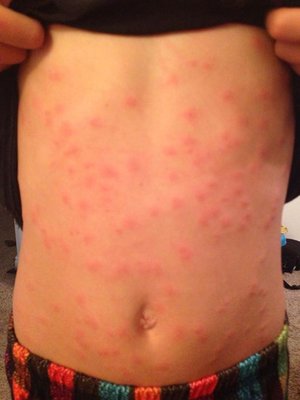

#CHIGGERS VS SWIMMERS ITCH SKIN#
Those containing zinc or titanium oxide - these are known as physical blockers - are the best bet for people susceptible to PMLE reactions, Allen says.Ī recent study tested sunscreens on 15 women with a history of PMLE for each woman, four patches of skin were monitored.

Products labeled “broad-spectrum” are formulated to guard against both UVA and UVB rays. Even the best sunscreens block only 40 to 50 percent of UVA rays.” “But they’re not so good at blocking the long UV rays, the UVA rays. “Sunscreens are pretty good at blocking short UV rays, the UVB rays that cause sunburn,” Allen says. Sunscreen products help, but they can’t entirely prevent PMLE. Next best is wearing clothes that offer sun protection. The best protection against PMLE is avoiding exposure to the sun altogether. “It’s too much sun, too quickly.” So when exposing your winter-hidden skin parts to the sun, go slow. “The condition tends to occur in the spring or early summer,” Sheu says. The reaction can emerge suddenly in one place, such as on arms exposed to the sun that first warm day in April. Its form varies - it can produce an itchy rash or blisters or raised red blotches - and its severity varies widely. While every type of skin type can get sunburned, PMLE is an allergic reaction to the sun’s ultraviolet rays. Calamine lotion or cortisone cream can also help.Īs for rashes caused by sun, polymorphous light eruption (PMLE) is the most common culprit, affecting about 10 to 20 percent of people in the Unites States. If you do, a heavy-duty moisturizer, especially one containing lanolin, can provide relief, Allen says. To prevent miliaria, wear lightweight clothing - and less of it, Allen says.Īnyone can get heat rash. “Adequate ventilation is the key,” says Mary Sheu, medical director of the Johns Hopkins Dermatology & Cosmetic Center. There’s no air flow.”įresh air, a breeze, air conditioning and fan-circulated air all help sweat evaporate and prevent heat rash. This sequence - you sweat and then your sweat glands clog - is more likely to occur, Allen says, “when you have too much clothing on - or too-tight clothes - or have been lying still on hospital bedsheets. The slime can block your sweat glands and trigger a rapid immune response that causes an itchy rash. The bacteria sense the salty wetness as a dangerous environment and throw out slime in defense. What makes staph bacteria produce biofilm? Salt and water - or sweat. (Pamela Kirkland, Gillian Brockell, and Kate M. Michael Irwig explains how sunlight, or lack of it, can affect a person's health. One of the best known benefits of sunlight is its ability to boost the body's vitamin D supply, but what happens when you can't get outside in the sun? George Washington University's Dr. “It coats and protects bacteria.” Biofilm can also clog up sweat glands. “It used to be called slime,” Allen says. Sometimes the bacteria produce a substance that scientists call biofilm. They both start with staphylococcus bacteria living on the skin, says Herb Allen, a dermatologist and researcher at Drexel University in Philadelphia. The chain of events is the same in heat rash as in eczema. The skin can feel irritated and itchy, giving rise to another common term for the syndrome - prickly heat. Heat rash, called miliaria by doctors, can cause the skin to redden if the glands are blocked in a deeper layer of the skin. Heat rash occurs when the sweat glands are blocked by tiny blisters - they resemble small beads of sweat - that form on the skin.

Your rash may be coming from two hard-to-escape realities of summer: heat and sun. You quickly rule out the usual suspects: You haven’t been gardening or hiking or even picnicking, so it’s probably not a plant irritant such as poison ivy or wild parsnip likewise, it’s probably not chiggers or ticks carrying Lyme disease and you haven’t been swimming in a pond, which can harbor the parasite that causes swimmer’s itch.


 0 kommentar(er)
0 kommentar(er)
